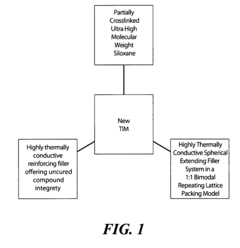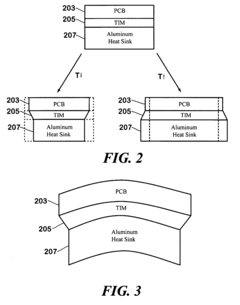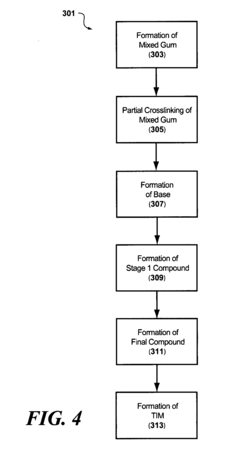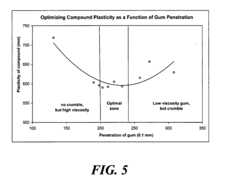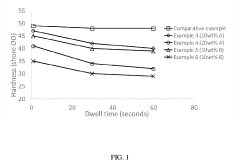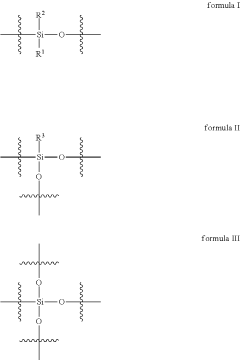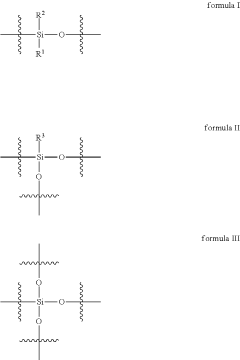Silicone Rubber's Role in Renewable Energy Systems
JUL 8, 20259 MIN READ
Generate Your Research Report Instantly with AI Agent
Patsnap Eureka helps you evaluate technical feasibility & market potential.
Silicone Rubber in Renewable Energy: Background and Objectives
Silicone rubber has emerged as a crucial material in the development and advancement of renewable energy systems. As the global focus shifts towards sustainable energy sources, the unique properties of silicone rubber have positioned it as an indispensable component in various renewable energy applications. This technological evolution has been driven by the increasing demand for more efficient, durable, and environmentally friendly energy solutions.
The journey of silicone rubber in renewable energy can be traced back to the mid-20th century when its exceptional thermal stability, electrical insulation properties, and weather resistance were first recognized. Since then, continuous research and development have expanded its applications across multiple renewable energy sectors, including solar, wind, and hydroelectric power generation.
In the solar energy industry, silicone rubber has played a pivotal role in enhancing the performance and longevity of photovoltaic modules. Its ability to withstand extreme temperatures, UV radiation, and moisture has made it an ideal material for encapsulation and sealing of solar cells. This has significantly contributed to the increased efficiency and lifespan of solar panels, driving down the cost of solar energy production.
Wind energy systems have also benefited greatly from silicone rubber technology. The material's flexibility, durability, and resistance to environmental factors have made it essential in the manufacturing of wind turbine components such as blade coatings, electrical insulation, and vibration dampeners. These applications have led to improved turbine performance, reduced maintenance requirements, and extended operational lifetimes.
In hydroelectric power generation, silicone rubber has found applications in sealing systems, gaskets, and insulation components. Its resistance to water and ability to maintain its properties under high pressure have made it invaluable in ensuring the reliability and efficiency of hydroelectric installations.
The primary objective of incorporating silicone rubber in renewable energy systems is to enhance the overall performance, reliability, and cost-effectiveness of these technologies. By leveraging the material's unique properties, researchers and engineers aim to overcome existing limitations in energy conversion efficiency, durability, and environmental adaptability.
Looking ahead, the role of silicone rubber in renewable energy is expected to expand further. Ongoing research focuses on developing advanced silicone formulations with improved thermal management capabilities, enhanced electrical properties, and even self-healing characteristics. These innovations are anticipated to push the boundaries of renewable energy technology, enabling more efficient and resilient energy systems that can accelerate the global transition to sustainable power sources.
The journey of silicone rubber in renewable energy can be traced back to the mid-20th century when its exceptional thermal stability, electrical insulation properties, and weather resistance were first recognized. Since then, continuous research and development have expanded its applications across multiple renewable energy sectors, including solar, wind, and hydroelectric power generation.
In the solar energy industry, silicone rubber has played a pivotal role in enhancing the performance and longevity of photovoltaic modules. Its ability to withstand extreme temperatures, UV radiation, and moisture has made it an ideal material for encapsulation and sealing of solar cells. This has significantly contributed to the increased efficiency and lifespan of solar panels, driving down the cost of solar energy production.
Wind energy systems have also benefited greatly from silicone rubber technology. The material's flexibility, durability, and resistance to environmental factors have made it essential in the manufacturing of wind turbine components such as blade coatings, electrical insulation, and vibration dampeners. These applications have led to improved turbine performance, reduced maintenance requirements, and extended operational lifetimes.
In hydroelectric power generation, silicone rubber has found applications in sealing systems, gaskets, and insulation components. Its resistance to water and ability to maintain its properties under high pressure have made it invaluable in ensuring the reliability and efficiency of hydroelectric installations.
The primary objective of incorporating silicone rubber in renewable energy systems is to enhance the overall performance, reliability, and cost-effectiveness of these technologies. By leveraging the material's unique properties, researchers and engineers aim to overcome existing limitations in energy conversion efficiency, durability, and environmental adaptability.
Looking ahead, the role of silicone rubber in renewable energy is expected to expand further. Ongoing research focuses on developing advanced silicone formulations with improved thermal management capabilities, enhanced electrical properties, and even self-healing characteristics. These innovations are anticipated to push the boundaries of renewable energy technology, enabling more efficient and resilient energy systems that can accelerate the global transition to sustainable power sources.
Market Demand Analysis for Sustainable Energy Solutions
The global shift towards sustainable energy solutions has significantly increased the demand for advanced materials in renewable energy systems. Silicone rubber, with its unique properties, has emerged as a crucial component in this rapidly expanding market. The demand for silicone rubber in renewable energy applications is driven by several factors, including the growing installation of solar photovoltaic (PV) systems, wind turbines, and energy storage solutions.
In the solar PV sector, silicone rubber plays a vital role in encapsulation and sealing applications. As the global solar PV capacity continues to grow at an unprecedented rate, the demand for silicone rubber in this segment is expected to surge. The material's excellent weather resistance, UV stability, and electrical insulation properties make it ideal for protecting solar cells and ensuring long-term performance of PV modules.
Wind energy, another key player in the renewable energy market, also relies heavily on silicone rubber components. The material is used in various applications within wind turbines, including blade coatings, electrical insulation, and sealing systems. As wind energy capacity expands globally, particularly in offshore installations, the demand for high-performance silicone rubber products is projected to increase significantly.
Energy storage systems, crucial for balancing the intermittent nature of renewable energy sources, represent another growing market for silicone rubber. The material's thermal management properties and chemical stability make it valuable in battery technologies and other energy storage applications. With the rapid growth of electric vehicles and grid-scale energy storage projects, this segment is expected to drive substantial demand for silicone rubber in the coming years.
The market demand for silicone rubber in renewable energy systems is further bolstered by stringent environmental regulations and sustainability goals set by governments worldwide. As countries strive to reduce carbon emissions and transition to cleaner energy sources, the adoption of renewable technologies is accelerating, consequently driving the demand for associated materials like silicone rubber.
Moreover, the increasing focus on improving the efficiency and longevity of renewable energy systems is creating opportunities for advanced silicone rubber formulations. Manufacturers are investing in research and development to enhance the material's properties, such as improved thermal conductivity, better adhesion, and increased durability under extreme conditions. This trend is expected to open new avenues for silicone rubber applications in the renewable energy sector.
In the solar PV sector, silicone rubber plays a vital role in encapsulation and sealing applications. As the global solar PV capacity continues to grow at an unprecedented rate, the demand for silicone rubber in this segment is expected to surge. The material's excellent weather resistance, UV stability, and electrical insulation properties make it ideal for protecting solar cells and ensuring long-term performance of PV modules.
Wind energy, another key player in the renewable energy market, also relies heavily on silicone rubber components. The material is used in various applications within wind turbines, including blade coatings, electrical insulation, and sealing systems. As wind energy capacity expands globally, particularly in offshore installations, the demand for high-performance silicone rubber products is projected to increase significantly.
Energy storage systems, crucial for balancing the intermittent nature of renewable energy sources, represent another growing market for silicone rubber. The material's thermal management properties and chemical stability make it valuable in battery technologies and other energy storage applications. With the rapid growth of electric vehicles and grid-scale energy storage projects, this segment is expected to drive substantial demand for silicone rubber in the coming years.
The market demand for silicone rubber in renewable energy systems is further bolstered by stringent environmental regulations and sustainability goals set by governments worldwide. As countries strive to reduce carbon emissions and transition to cleaner energy sources, the adoption of renewable technologies is accelerating, consequently driving the demand for associated materials like silicone rubber.
Moreover, the increasing focus on improving the efficiency and longevity of renewable energy systems is creating opportunities for advanced silicone rubber formulations. Manufacturers are investing in research and development to enhance the material's properties, such as improved thermal conductivity, better adhesion, and increased durability under extreme conditions. This trend is expected to open new avenues for silicone rubber applications in the renewable energy sector.
Current Challenges in Silicone Rubber Applications
Despite the widespread use of silicone rubber in renewable energy systems, several challenges persist in its applications. One of the primary issues is the material's long-term durability under extreme environmental conditions. Renewable energy installations, such as solar panels and wind turbines, are often exposed to harsh weather, UV radiation, and temperature fluctuations. While silicone rubber exhibits excellent resistance to these factors, prolonged exposure can lead to degradation, affecting its performance and lifespan.
Another significant challenge is the optimization of silicone rubber formulations for specific renewable energy applications. Different components in renewable energy systems require varying properties from silicone rubber, such as electrical insulation, thermal conductivity, or mechanical flexibility. Developing tailored formulations that meet these diverse requirements while maintaining cost-effectiveness remains a complex task for manufacturers.
The adhesion of silicone rubber to other materials used in renewable energy systems poses another hurdle. Ensuring strong and durable bonds between silicone rubber and substrates like glass, metals, or plastics is crucial for the longevity and reliability of components. Improving adhesion techniques and developing compatible adhesion promoters are ongoing areas of research and development.
Thermal management is a critical challenge in many renewable energy applications, particularly in solar photovoltaic systems. While silicone rubber offers good thermal stability, enhancing its heat dissipation properties without compromising other essential characteristics remains a focus area for material scientists and engineers.
The electrical properties of silicone rubber, while generally favorable, present challenges in certain high-voltage applications within renewable energy systems. Improving the material's dielectric strength and resistance to electrical tracking and erosion is necessary to meet the demanding requirements of modern renewable energy infrastructure.
Manufacturing processes for silicone rubber components in renewable energy systems also face challenges. Achieving consistent quality, reducing production costs, and scaling up production to meet growing demand are ongoing concerns. Additionally, the development of more efficient and environmentally friendly manufacturing techniques aligns with the sustainability goals of the renewable energy sector.
Lastly, the end-of-life management and recyclability of silicone rubber components in renewable energy systems present environmental challenges. As the industry moves towards more sustainable practices, finding effective ways to recycle or safely dispose of silicone rubber materials becomes increasingly important, requiring innovative solutions and potential regulatory changes.
Another significant challenge is the optimization of silicone rubber formulations for specific renewable energy applications. Different components in renewable energy systems require varying properties from silicone rubber, such as electrical insulation, thermal conductivity, or mechanical flexibility. Developing tailored formulations that meet these diverse requirements while maintaining cost-effectiveness remains a complex task for manufacturers.
The adhesion of silicone rubber to other materials used in renewable energy systems poses another hurdle. Ensuring strong and durable bonds between silicone rubber and substrates like glass, metals, or plastics is crucial for the longevity and reliability of components. Improving adhesion techniques and developing compatible adhesion promoters are ongoing areas of research and development.
Thermal management is a critical challenge in many renewable energy applications, particularly in solar photovoltaic systems. While silicone rubber offers good thermal stability, enhancing its heat dissipation properties without compromising other essential characteristics remains a focus area for material scientists and engineers.
The electrical properties of silicone rubber, while generally favorable, present challenges in certain high-voltage applications within renewable energy systems. Improving the material's dielectric strength and resistance to electrical tracking and erosion is necessary to meet the demanding requirements of modern renewable energy infrastructure.
Manufacturing processes for silicone rubber components in renewable energy systems also face challenges. Achieving consistent quality, reducing production costs, and scaling up production to meet growing demand are ongoing concerns. Additionally, the development of more efficient and environmentally friendly manufacturing techniques aligns with the sustainability goals of the renewable energy sector.
Lastly, the end-of-life management and recyclability of silicone rubber components in renewable energy systems present environmental challenges. As the industry moves towards more sustainable practices, finding effective ways to recycle or safely dispose of silicone rubber materials becomes increasingly important, requiring innovative solutions and potential regulatory changes.
Existing Silicone Rubber Solutions in Renewable Energy
01 Composition and preparation of silicone rubber
Silicone rubber is typically composed of silicone polymers, fillers, and curing agents. The preparation process often involves mixing these components, shaping the mixture, and then curing it to form the final rubber product. Various additives can be incorporated to modify properties such as strength, flexibility, and heat resistance.- Composition and preparation of silicone rubber: Silicone rubber is typically composed of silicone polymers, fillers, and curing agents. The preparation process often involves mixing these components, shaping the mixture, and then curing it to form the final rubber product. Various additives can be incorporated to enhance specific properties such as strength, flexibility, or heat resistance.
- Modification of silicone rubber properties: The properties of silicone rubber can be modified through the addition of specific compounds or by altering the molecular structure. This can include improving thermal stability, increasing electrical conductivity, enhancing mechanical strength, or adjusting the rubber's hardness. Such modifications allow for the customization of silicone rubber for various applications.
- Silicone rubber in medical and healthcare applications: Silicone rubber is widely used in medical and healthcare products due to its biocompatibility, flexibility, and durability. Applications include medical implants, prosthetics, drug delivery systems, and various medical devices. The material can be formulated to meet specific requirements such as antimicrobial properties or controlled drug release.
- Silicone rubber composites and blends: Silicone rubber can be combined with other materials to create composites or blends with enhanced properties. This includes mixing with other polymers, incorporating nanoparticles, or adding reinforcing fibers. These composites can exhibit improved mechanical strength, thermal conductivity, or specific functional properties tailored for particular applications.
- Manufacturing processes for silicone rubber products: Various manufacturing processes are employed to produce silicone rubber products, including injection molding, extrusion, compression molding, and 3D printing. Each method has specific advantages and is suited for different types of products or production scales. Innovations in manufacturing techniques focus on improving efficiency, reducing waste, and enhancing product quality.
02 Modification of silicone rubber properties
The properties of silicone rubber can be modified through the addition of specific compounds or by altering the manufacturing process. This can include improving thermal stability, enhancing electrical properties, or increasing chemical resistance. Techniques may involve blending with other polymers or incorporating nanoparticles.Expand Specific Solutions03 Applications of silicone rubber
Silicone rubber finds wide applications across various industries due to its unique properties. It is used in medical devices, automotive parts, electrical insulation, cookware, and construction materials. Its biocompatibility makes it suitable for implants and prosthetics, while its heat resistance is valuable in industrial seals and gaskets.Expand Specific Solutions04 Silicone rubber processing techniques
Various processing techniques are employed in the manufacture of silicone rubber products. These may include injection molding, extrusion, compression molding, and liquid silicone rubber molding. Each technique offers specific advantages in terms of product shape, size, and production efficiency.Expand Specific Solutions05 Innovations in silicone rubber technology
Recent innovations in silicone rubber technology focus on enhancing performance and expanding applications. This includes developing self-healing silicone rubbers, improving adhesion properties, creating conductive silicone rubbers, and formulating eco-friendly alternatives. Research also explores the integration of silicone rubber with smart materials for advanced functionalities.Expand Specific Solutions
Key Players in Silicone Rubber and Renewable Energy
The market for silicone rubber in renewable energy systems is experiencing rapid growth, driven by increasing global demand for clean energy solutions. The industry is in an expansion phase, with the global silicone market expected to reach significant size in the coming years. Technologically, silicone rubber applications in renewable energy are advancing, with key players like Shin-Etsu Chemical, Dow Silicones, and Momentive Performance Materials leading innovation. These companies are developing high-performance silicone materials tailored for solar panels, wind turbines, and energy storage systems, focusing on enhancing durability, efficiency, and weather resistance. The competitive landscape is intensifying as more firms recognize the potential in this sector, spurring further technological advancements and market expansion.
Shin-Etsu Chemical Co., Ltd.
Technical Solution: Shin-Etsu Chemical has developed advanced silicone rubber compounds specifically designed for renewable energy applications. Their silicone materials are used in photovoltaic module manufacturing, offering excellent weather resistance and durability[1]. The company's silicone encapsulants and adhesives provide protection against moisture, UV radiation, and thermal stress, extending the lifespan of solar panels[2]. In wind energy, Shin-Etsu's specialized silicone rubber is used for blade coatings and electrical insulation, improving turbine efficiency and reliability[3]. Their materials also find applications in fuel cells and energy storage systems, contributing to the overall performance and longevity of renewable energy infrastructure[4].
Strengths: High-performance materials, extensive R&D capabilities, global market presence. Weaknesses: Potential high costs, dependency on raw material supply chains.
Dow Silicones Corp.
Technical Solution: Dow Silicones Corp. has developed a range of silicone-based solutions for renewable energy systems. Their DOWSIL™ brand offers silicone adhesives and sealants specifically engineered for solar panel assembly and installation, providing excellent bonding strength and weather resistance[1]. In wind energy, Dow's silicone materials are used for blade coatings and electrical insulation, enhancing turbine performance and longevity[2]. The company has also introduced innovative silicone thermal management solutions for power electronics in renewable energy systems, improving heat dissipation and overall efficiency[3]. Dow's research focuses on developing silicone materials with enhanced UV resistance and electrical properties, addressing the specific challenges of renewable energy applications[4].
Strengths: Broad product portfolio, strong technical expertise, global distribution network. Weaknesses: Environmental concerns related to silicone production, competition from alternative materials.
Innovative Silicone Rubber Technologies for Energy Systems
Silicone based compositions for thermal interface materials
PatentInactiveUS20080166552A1
Innovation
- A silicone-based composition with a partially crosslinked polyorganosiloxane continuous phase, incorporating fumed titanium dioxide coated with a silane functional coating, and a combination of spherical extending fillers like boron nitride and aluminum oxide, optimized for calendaring, extruding, and molding processes, which enhances thermal conductivity and mechanical properties.
Curable Organopolysiloxane Composition Containing Dynamic Covalent Polysiloxane
PatentActiveUS20200239639A1
Innovation
- A curable organopolysiloxane composition is developed, comprising alkenyl-containing and hydride-containing organopolysiloxanes with dynamic covalent bonds and a metal complex catalyst, which upon curing, forms a silicone rubber with adaptive elastomeric and viscous characteristics, including self-healing and shape memory properties.
Environmental Impact of Silicone Rubber in Energy Systems
The environmental impact of silicone rubber in energy systems is a critical consideration as renewable energy technologies continue to expand. Silicone rubber, widely used in various components of renewable energy systems, offers both advantages and challenges from an environmental perspective.
One of the primary environmental benefits of silicone rubber in energy systems is its durability and longevity. The material's resistance to weathering, UV radiation, and extreme temperatures contributes to extended lifespans of renewable energy components. This longevity reduces the frequency of replacements, thereby minimizing waste generation and the environmental impacts associated with manufacturing and disposal processes.
However, the production of silicone rubber does have environmental implications. The manufacturing process involves energy-intensive steps and the use of chemical precursors, which can contribute to greenhouse gas emissions and potential chemical pollution if not properly managed. Additionally, the extraction of raw materials, primarily silica and methyl chloride, can have localized environmental impacts on ecosystems and landscapes.
In terms of end-of-life considerations, silicone rubber presents both opportunities and challenges. While the material is not biodegradable, it can be recycled through specialized processes. These recycling methods, though not yet widely implemented, offer the potential to reduce the environmental footprint of silicone rubber use in energy systems. However, the current limited recycling infrastructure means that a significant portion of silicone rubber waste still ends up in landfills or incineration facilities.
The application of silicone rubber in renewable energy systems also contributes to overall environmental benefits by enhancing the efficiency and reliability of these systems. For instance, in solar panels, silicone-based sealants and encapsulants protect photovoltaic cells from moisture and environmental stressors, extending their operational life and maintaining their efficiency. Similarly, in wind turbines, silicone-based lubricants and insulation materials improve performance and reduce maintenance requirements, indirectly contributing to the environmental benefits of renewable energy generation.
Looking towards the future, ongoing research and development efforts are focused on improving the environmental profile of silicone rubber. This includes exploring bio-based alternatives for certain components, enhancing recycling technologies, and optimizing manufacturing processes to reduce energy consumption and emissions. These advancements have the potential to further mitigate the environmental impact of silicone rubber in energy systems, aligning with broader sustainability goals in the renewable energy sector.
One of the primary environmental benefits of silicone rubber in energy systems is its durability and longevity. The material's resistance to weathering, UV radiation, and extreme temperatures contributes to extended lifespans of renewable energy components. This longevity reduces the frequency of replacements, thereby minimizing waste generation and the environmental impacts associated with manufacturing and disposal processes.
However, the production of silicone rubber does have environmental implications. The manufacturing process involves energy-intensive steps and the use of chemical precursors, which can contribute to greenhouse gas emissions and potential chemical pollution if not properly managed. Additionally, the extraction of raw materials, primarily silica and methyl chloride, can have localized environmental impacts on ecosystems and landscapes.
In terms of end-of-life considerations, silicone rubber presents both opportunities and challenges. While the material is not biodegradable, it can be recycled through specialized processes. These recycling methods, though not yet widely implemented, offer the potential to reduce the environmental footprint of silicone rubber use in energy systems. However, the current limited recycling infrastructure means that a significant portion of silicone rubber waste still ends up in landfills or incineration facilities.
The application of silicone rubber in renewable energy systems also contributes to overall environmental benefits by enhancing the efficiency and reliability of these systems. For instance, in solar panels, silicone-based sealants and encapsulants protect photovoltaic cells from moisture and environmental stressors, extending their operational life and maintaining their efficiency. Similarly, in wind turbines, silicone-based lubricants and insulation materials improve performance and reduce maintenance requirements, indirectly contributing to the environmental benefits of renewable energy generation.
Looking towards the future, ongoing research and development efforts are focused on improving the environmental profile of silicone rubber. This includes exploring bio-based alternatives for certain components, enhancing recycling technologies, and optimizing manufacturing processes to reduce energy consumption and emissions. These advancements have the potential to further mitigate the environmental impact of silicone rubber in energy systems, aligning with broader sustainability goals in the renewable energy sector.
Regulatory Framework for Silicone Rubber in Energy Applications
The regulatory framework for silicone rubber in energy applications is a complex and evolving landscape that plays a crucial role in shaping the adoption and implementation of this material in renewable energy systems. As the use of silicone rubber expands in various energy-related applications, regulatory bodies worldwide have been developing and refining guidelines to ensure safety, reliability, and environmental compliance.
One of the primary regulatory considerations for silicone rubber in energy applications is its compliance with electrical safety standards. Organizations such as the International Electrotechnical Commission (IEC) and Underwriters Laboratories (UL) have established specific requirements for insulation materials used in electrical systems. These standards often include tests for dielectric strength, flame resistance, and long-term thermal stability, which silicone rubber must meet to be approved for use in energy infrastructure.
Environmental regulations also significantly impact the use of silicone rubber in renewable energy systems. Many countries have implemented strict guidelines regarding the use of materials in energy production to minimize environmental impact. For instance, the European Union's Restriction of Hazardous Substances (RoHS) directive limits the use of certain hazardous materials in electrical and electronic equipment, including those used in renewable energy systems. Silicone rubber manufacturers must ensure their products comply with these regulations to be viable for use in the EU market.
In the context of renewable energy, specific regulations govern the use of materials in solar panels, wind turbines, and other clean energy technologies. For example, the International Electrotechnical Commission Technical Committee 82 (IEC TC 82) has developed standards for photovoltaic systems, which include specifications for materials used in solar panel construction and installation. Silicone rubber components used in these applications must adhere to these standards to ensure long-term performance and safety.
The regulatory framework also extends to the manufacturing processes of silicone rubber. Environmental protection agencies in various countries have established guidelines for the production and disposal of silicone materials to minimize pollution and waste. These regulations often require manufacturers to implement sustainable practices and proper waste management systems.
As the renewable energy sector continues to grow, regulatory bodies are increasingly focusing on the lifecycle assessment of materials used in energy systems. This includes evaluating the environmental impact of silicone rubber from production to disposal. Manufacturers are now required to provide detailed information on the carbon footprint and recyclability of their products, influencing the selection of materials for energy applications.
The global nature of the renewable energy market necessitates harmonization of regulatory standards across different regions. International organizations such as the International Organization for Standardization (ISO) are working towards creating unified standards for materials used in energy applications, including silicone rubber. This effort aims to facilitate global trade and ensure consistent quality and safety standards worldwide.
One of the primary regulatory considerations for silicone rubber in energy applications is its compliance with electrical safety standards. Organizations such as the International Electrotechnical Commission (IEC) and Underwriters Laboratories (UL) have established specific requirements for insulation materials used in electrical systems. These standards often include tests for dielectric strength, flame resistance, and long-term thermal stability, which silicone rubber must meet to be approved for use in energy infrastructure.
Environmental regulations also significantly impact the use of silicone rubber in renewable energy systems. Many countries have implemented strict guidelines regarding the use of materials in energy production to minimize environmental impact. For instance, the European Union's Restriction of Hazardous Substances (RoHS) directive limits the use of certain hazardous materials in electrical and electronic equipment, including those used in renewable energy systems. Silicone rubber manufacturers must ensure their products comply with these regulations to be viable for use in the EU market.
In the context of renewable energy, specific regulations govern the use of materials in solar panels, wind turbines, and other clean energy technologies. For example, the International Electrotechnical Commission Technical Committee 82 (IEC TC 82) has developed standards for photovoltaic systems, which include specifications for materials used in solar panel construction and installation. Silicone rubber components used in these applications must adhere to these standards to ensure long-term performance and safety.
The regulatory framework also extends to the manufacturing processes of silicone rubber. Environmental protection agencies in various countries have established guidelines for the production and disposal of silicone materials to minimize pollution and waste. These regulations often require manufacturers to implement sustainable practices and proper waste management systems.
As the renewable energy sector continues to grow, regulatory bodies are increasingly focusing on the lifecycle assessment of materials used in energy systems. This includes evaluating the environmental impact of silicone rubber from production to disposal. Manufacturers are now required to provide detailed information on the carbon footprint and recyclability of their products, influencing the selection of materials for energy applications.
The global nature of the renewable energy market necessitates harmonization of regulatory standards across different regions. International organizations such as the International Organization for Standardization (ISO) are working towards creating unified standards for materials used in energy applications, including silicone rubber. This effort aims to facilitate global trade and ensure consistent quality and safety standards worldwide.
Unlock deeper insights with Patsnap Eureka Quick Research — get a full tech report to explore trends and direct your research. Try now!
Generate Your Research Report Instantly with AI Agent
Supercharge your innovation with Patsnap Eureka AI Agent Platform!
